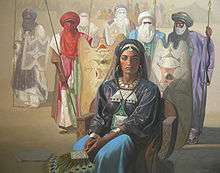Tin Hinan
| Tin Hinan | |
|---|---|
| Tamenukalt | |
 The Queen Tin Hinan, Oil painting, 125x150cm | |
| Reign | 4th-century |
Tin Hinan is the name given by the Tuareg to a 4th-century queen and warrior woman of prestige whose monumental tomb is located in the Sahara at Abalessa in the Hoggar region of Algeria.
Queen of the Hoggar
Tin Hinan is sometimes referred to as "Queen of the Hoggar", and by the Tuareg as Tamenukalt which also means "leader" or "queen". The name means literally "she of the tents", but may be metaphorically translated as "mother of the tribe" (or "of us all") or even "queen of the camp" (the "camp" maybe referring to the group of tombs which surround hers).
Not far from the oasis of Abalessa, Algeria (See Google Earth) about 1,000 miles south of Algiers, a rounded hill rises about 125 ft above the junction of two wadis. The tomb of Tin Hinan is on the summit. The ruin is pear-shaped on plan with a major axis of about 88 ft. It contains 11 room or courts.
The tomb of Tin Hinan was opened by Byron Khun de Prorok with support from the French army in 1925, and archaeologists made a more thorough investigation in 1933. It was found to contain the skeleton of a woman (probably buried in the fourth century AD) on a wooden litter, lying on her back with her head facing east. She was accompanied by heavy gold and silver jewellery, some of it adorned with pearls. On her right forearm she wore 7 silver bracelets, and on her left, 7 gold bracelets. Another silver bracelet and a gold ring were placed with the body. Remains of a complex piecework necklace of gold and pearls (real and artificial) were also present.
A number of funerary objects were also found. These included a "Venus" statue in Aurignacian style (similar to the Venus of Hohle Fels), a glass goblet (lost during World War II), barbed arrowheads of iron, an iron knife, and a gold foil which bore the imprint of a Roman coin of Constantine I issued between 308 and 324 CE. A 4th to 5th century date is consistent with carbon dating of the wooden bed and also with the style of pottery, a pottery lamp of third-century Roman type, and other tomb furniture. Tifinagh inscriptions are inscribed on the wall stones. The tomb itself is constructed in a style that is widespread in the Sahara.
An anthropological study of the remains published in 1968 concluded the skeleton was that of a woman 1.72 to 1.76 metres tall, belonging to a Mediterranean race, who had probably never had children and who was probably lame because of deformation of the lumbar and sacral areas. The body is now in the Bardo Museum in Algiers.
The Tuareg were well aware that the tomb contained a woman of prestige and a number of legends about her had long been in circulation before the tomb was opened. The 14th-century historian Ibn Khaldun recorded a legend about a lame queen named Tiski who was ancestral mother of the Ahaggar tribes, which is somewhat close to the archaeological record. In other legends less corroborated, Tin Hinan was believed to have been a Muslim of the Braber tribe of Berbers who came from Tafilalt oasis in the Atlas Mountains in the area of modern Morocco accompanied by a maidservant named Takamat. In this legend, Tin Hinan had a daughter (or granddaughter), whose name is Kella, while Takamat had two daughters. These children are said to be the ancestors of the Tuareg of the Ahaggar. Another version is that Tin Hinan had three daughters (who had totemic names referring to desert animals) who were the tribal ancestors.
Her Muslim religion is anachronistic, as is the statement that Kella was her daughter or granddaughter, because the historical figure and real tribal matriarch[1] Kella lived during the 17th century.
Notes
- ↑ Tribal genealogies show male descent until her, after which descent was reckoned in the female line. Camps, p. 516.
Bibliography
- Gabriel Camps, "L'âge du tombeau de Tin Hinan, ancêtre des Touareg du Hoggar". Zephyrus, vol. 25 (1974) 497-516.
- Brett, Michael; Elizabeth Fentress The Berbers WileyBlackwell 1997 ISBN 978-0-631-20767-2 p. 208
- Wheeler, Sir Mortimer, Rome Beyond the Imperial Frontier, Penguin Books, 1955, pp. 133-137.